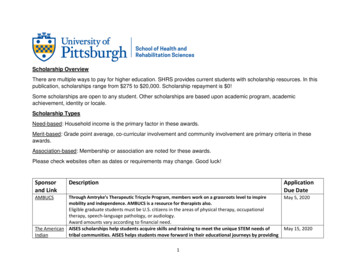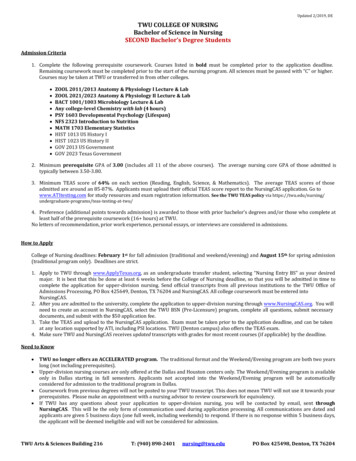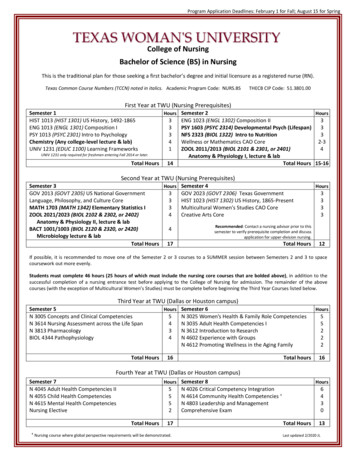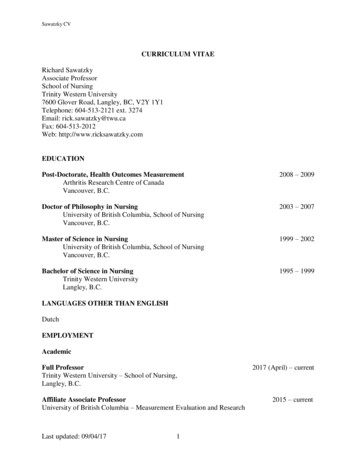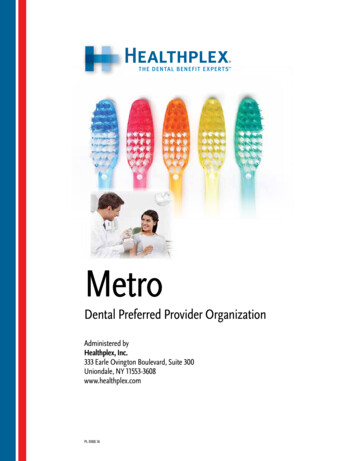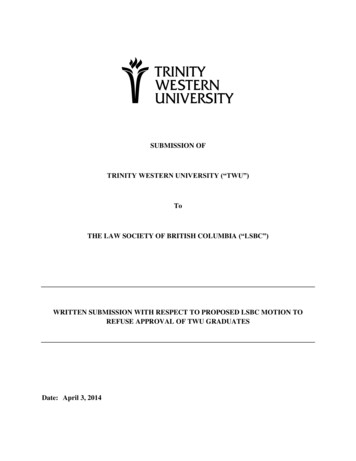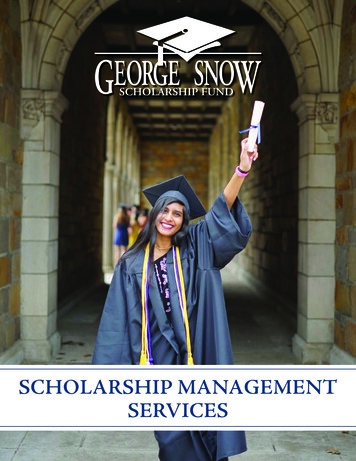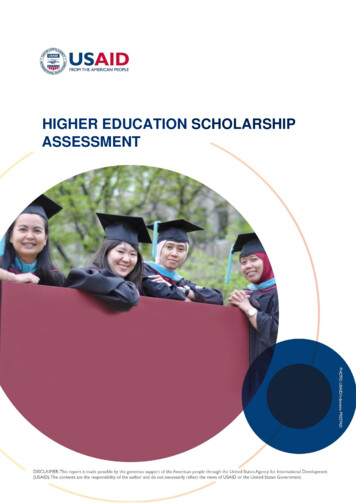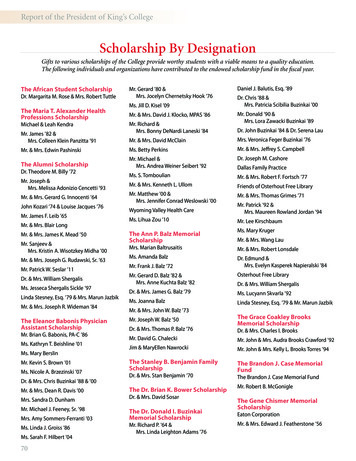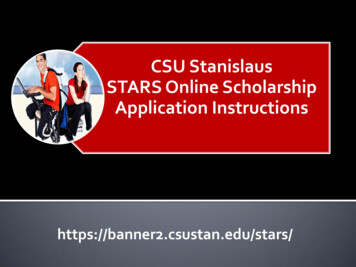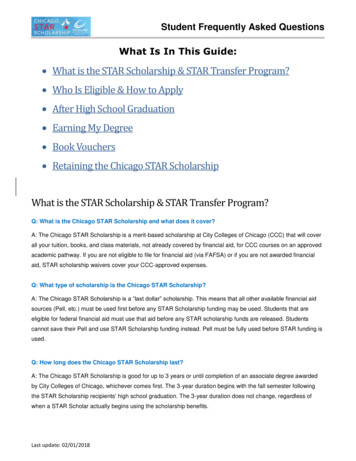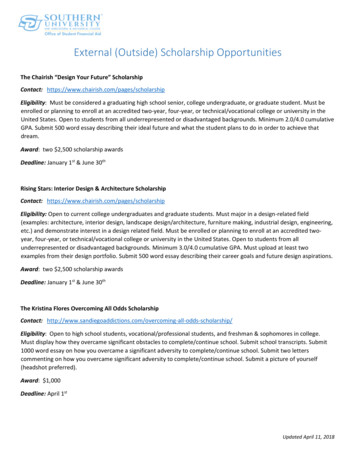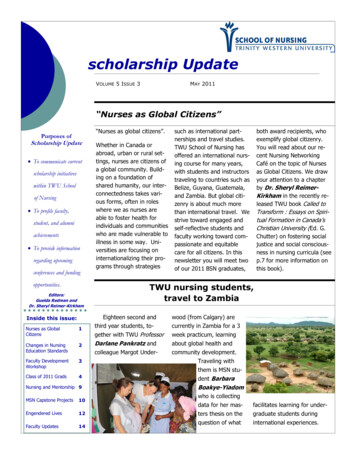
Transcription
scholarship UpdateVOLUME 5 ISSUE 3MAY 2011“Nurses as Global Citizens”―Nurses as global citizens‖.Purposes ofScholarship UpdateTo communicate currentscholarship initiativeswithin TWU Schoolof NursingTo profile faculty,student, and alumniachievementsTo provide informationregarding upcomingconferences and fundingopportunities.Editors:Guelda Redman andDr. Sheryl Reimer-KirkhamWhether in Canada orabroad, urban or rural settings, nurses are citizens ofa global community. Building on a foundation ofshared humanity, our interconnectedness takes various forms, often in roleswhere we as nurses areable to foster health forindividuals and communitieswho are made vulnerable toillness in some way. Universities are focusing oninternationalizing their programs through strategiesboth award recipients, whoexemplify global citizenry.You will read about our recent Nursing NetworkingCafé on the topic of Nursesas Global Citizens. We drawyour attention to a chapterby Dr. Sheryl ReimerKirkham in the recently released TWU book Called toTransform : Essays on Spiritual Formation in Canada‘sChristian University (Ed. G.Chutter) on fostering socialjustice and social consciousness in nursing curricula (seep.7 for more information onthis book).TWU nursing students,travel to ZambiaEighteen second andInside this issue:such as international partnerships and travel studies.TWU School of Nursing hasoffered an international nursing course for many years,with students and instructorstraveling to countries such asBelize, Guyana, Guatemala,and Zambia. But global citizenry is about much morethan international travel. Westrive toward engaged andself-reflective students andfaculty working toward compassionate and equitablecare for all citizens. In thisnewsletter you will meet twoof our 2011 BSN graduates,wood (from Calgary) areNurses as GlobalCitizens1third year students, to-currently in Zambia for a 3gether with TWU Professorweek practicum, learningChanges in NursingEducation Standards2Darlane Pankratz andabout global health andcolleague Margot Under-community development.Faculty DevelopmentWorkshop3Class of 2011 Grads4Traveling withthem is MSN stu-Nursing and Mentorship 9MSN Capstone Projects10Engendered Lives12Faculty Updates14dent BarbaraBoakye-Yiadomwho is collectingdata for her mas-facilitates learning for under-ters thesis on thegraduate students duringquestion of whatinternational experiences.
PAGE 2VOLUME 5 ISSUE 3Changes in CRNBC’s Nursing Education Standards and Indicatorsby Dr. Landa Terblanche, Dean, School of Nursingnursing education program,demonstrate progress towards achieving professionalpractice requirements.(c) Graduates - Graduates of thenursing education programachieve professional practicerequirements.During 2010, the EPRC consideredrevisions to the three nursing education standards and indicators foreach.Dr. Landa TerblancheDean School of Nursing;Trinity Western UniversityI am privileged to serve on the Education Program Committee (EPRC) ofthe CRNBC. The EPRC is a statutorycommittee that reviews programsand courses required by applicantsfor registration and recommends toCRNBC Board whether the Boardshould recognize programs andcourses and any terms or conditionsof recognition.The mandate of the EPRC, under theHealth Professions Act, includes aregular review of policies and procedures for program/course review.The following are the standardsagainst which nursing education programs or courses are reviewed andevaluated:(a) Curriculum - The curriculumprovides learning experiences necessary for students to achieve professional practice requirements.(b) Students - Students, duringtheir participation in theBased on evidence received throughvarious surveys, focus groups, external legal and policy analysis and gaining information about the nursingeducation standard and review process used in other nursing regulatorybodies for RN‘s across Canada, theEPRC decided not to make changes tothe standards at this stage and tomake multiple changes to the indicators of each standard. The EPRC conceptualized the three standards asthe curriculum (structure/plan); students (implementation/processes);and graduates (outcomes of a program). The EPRC concluded that allthree standards have implications forpublic protection because their assessment is based on evidence aboutwhether the graduates are likely toprovide safe, competent, ethical nursing care and therefore be eligible forregistration with CRNBC. From theevidence received, it was clear thatchanges were needed in numerousindicators. The EPRC presented a total number of 21 revised indicatorsto the Board, which were approvedon May 1, 2011. The EPRC is in theprocess of developing guidelines withexamples of supporting evidence foreach revised indicator of the nursingeducation standards. The examplesare intended to provide guidancefor the kinds of evidence programsmay wish to include in the selfevaluation reports submitted forEPRC assessment.I believe these changes will behelpful when writing our next TWUSchool of Nursing self assessmentreport in 2013, since the focus willnow be on the essentials for program recognition.Dr. Terblanche serves on several provincial and nationalcommittees in her role asDean:Nurse Educators Committee ofBC: Committee of allDeans/ Program Directors/Chairs of Nursing Schools/Programs in BCCRNBC – Education ProgramReview Committee (Chair)Deans and Director‘s Committee of BCLower Mainland Nursing Clinical Education SteeringCommittee (Co-Chair)CASN: Program reviewerCASN: Standing Committee onEducationCASN: Working Group on Competency GuidelinesCASN: Baccalaureate PositionStatement Working GroupTWU School of Nursing iswell represented atprovincial and nationallevels!
SCHOLARSHIPPAGE 3UPDATEEnhancing Online Learning: TWU Nursing Faculty and AffiliatesGather for Professional Development WorkshopIt was ―back to the classroom‖ fortwo days of inspired learning. Eighteen nursing faculty and affiliatesimmersed in a 2 day workshop ononline learning in early May withguest facilitator and expert, Dr.Margie Edwards. Dr. Edwards is Professor and Associate Dean, Faculty ofHealth Disciplines & Centre for Nursing and Health Studies, AthabascaUniversity. The workshop began onThursday evening with an explorationof the values we hold in regard toteaching and learning. Words such as―transformative‖, ―life long learning‖, and ―coaching‖ were used.The next morning we focused ongraduate supervision, a processquintessential to the graduate experience, and that nonethelessdoes not receive much intentionalfocus. Faculty discussed effectivestrategies and challenges that mightbe encountered. Dr. Edwards continued the workshop, presenting amodel for online learning, variouslearner-driven teaching strategies,and recent research findings on enhancing online teaching.NURSING NETWORKING CAFÉOn April 5th, 2011 more than fortystudents and nurses gathered in theGraduate Collegium for this year‘sthird Nursing Networking Café. Everyone was keen to engage in ourtopic ―nurses as global citizens‖.Launching the discussion were twoMSN students, Caroline Burgessand Barbara Boakye-Yiadom,who presented some of the currentthinking on global health, drawingour attention to a central theme forthe evening: global is everywhere!TWU nursing alumnus JanelleBaerg (class of 2006) and campusnurse Michele Regier spoke oftheir experiences with disaster reliefin Haiti. Emma Strobell (class of10) told us about her involvement inThailand at a shelter for girls involved in the sex industry. Gueststhen gathered in smaller groups todiscuss what they had heard, responding to questions such as: ―Inwhat ways do you think the conceptof global citizenship can be incorporated into the undergraduate nursingcurriculum? What criteria should beincluded?‖ and ―Nurse scholars suchas Mills, Astle, Ogilvie and Gastaldoare increasingly suggesting that―global citizenship is a critical component of the roles and responsibilitiesof professional nurses‖. Do you thinkmost nurses would agree with thisstatement? What should these rolesand responsibilities looklike?‖ The Café endedwith comments by Laurel Wichmann, CRNBCNursing Practice Advisor, who reminded usthat as members ofCRNBC, we are held tothe same Standards ofPractice, regardless ofwhat context we are in.Canadian nurses whovolunteer in international settingsmust practice within the same scopeof practice as in Canada. Many attendees lingered at the end of the evening, enjoying the venue, the collegiality, and the thought-provoking conversations.Do you have a suggestion for a topicor a guest speaker for the 2011/2012Café series?Please contact Dr. Sheryl ReimerKirkham at Sheryl.Kirkham@twu.ca
VOLUME 5 ISSUE 3PAGE 4Congratulations to TWU’s Largest Nursing Graduating Class!Class of 2011Kimberly BakkerKatie HawdonHadassah MoesEmily BaumSamantha HehrAnaliese MulderKirsten BuchholzCheryl HillmanIna ParkKate BushClaire HortonSue PaterCarmen ByleMari JeanMelissa PatzerAmy CampbellTessa JohnsonSonia ReitsmaAshley ChinKirsten KerrKatie RempelJenae CraigKim KlassenKelly SchootenKay DavisonJessica KleingeltinkChristina SebensCharmaine de JongJessica LeeLeanne SturchAlicia DueckJiSoo LeeAmanda WilliamsEmily EerkesAshley LowryMelanie WilsonMarlee FastJalene LuymesGrace XieChelsea FroeseGenelle McKenzieErin GillDana MillsRachel GrantPINNING CEREMONYMany friends and family gathered to honour 44 BSNgraduates on April 28th at our Pinning Ceremony heldat Langley Immanuel Christian Reformed Church inLangley. Students reflected on their years at University,faculty highlighted characteristics of the class, and Dr.Sonya Grypma gave the charge to the class buildingon the example of a ―surgical pause‖ that gives an operating team a collective moment of focus before beginning an operation, likening this to the student-tonurse transition. Graduates also received their TWUnursing pin from Dean Landa Terblanche. Two students were honoured with awards at the ceremony.
PAGE 5SCHOLARSHIPUPDATENursing Graduates Recognized for AccomplishmentsCongratulations to Susan Pater, recipient of this year‘s School of Nursing AcademicAchievement award.With her permission, here is an excerpt from her graduating philosophy of nursing paper (whatTWU alums fondly refer to as their PPPNs):Beauty in the Broken: The Gift of NursingOver the past four years at Trinity Western University I have come to see nursing as a true privilege and a profound gift. It is an honor to journey with persons during times of hardship, loss,uncertainty, vulnerability and dependence (Bowcutt, 2004). In a society that idolizes independSue Paterence, the healthcare setting serves as a reminder of humanity‘s dependence. When a personenters the healthcare system it is most often for a situation of brokenness. They are received by nurses in a vulnerable state in need of service. I see this vulnerability as a beautiful gift and a great opportunity. It is good to needothers, and in fact it is a gift to be needed, to belong (Vanier, 2008). Nurses are faced with a great opportunity tocare for persons when they are vulnerable, when they are often willing to let someone help them, to serve them. Ina society focused solely on the strength of independence, nursing provides a great platform to remind people oftheir humanness and of the beauty in this vulnerable, dependent state. Nursing is a realm that occurs in and for thebeauty in the broken . . As Christ‘s call remains foundational to my nursing practice, it was near imperative to study nursing atTrinity Western University. The privilege to study from a faith-based perspective was essential in shaping my PPPN.There are two terms that have resonated with me during the course of my program initially introduced during myfirst year of nursing. These words have blossomed and taken on new meaning in relation to my nursing practice.They have caused me to ponder, to be inspired, to serve, to mature, and to cultivate my PPPN.The first word is reflect or reflection. To me, this word has two basic meanings. When initially introduced tome it meant engagement in deep, contemplative thought, an act of looking back on a situation (Grypma, 2008). Iwas taught that the act of reflection was imperative to nursing practice, to look back on the situations I was placedin, the care I provided, the outcomes, and the changes that I could have made. It provides an opportunity to learn,and therefore to better my practice. As I pondered this word, it came to take on a deeper meaning for me, that of amirrored image. Every human being was created in the image of God (imageo Dei), an image of love I am called toreflect and to perceive in those around me.The second word that has resonated with me is balance. This is a word that was initially penned inregards to equilibrium between the four main concepts of relationships and intimacy, work and learning, health andbody, and spirituality (Boyce, 2007). As the program progressed to the intricacies of the human body, the term balance took on a more scientific meaning in the form of homeostasis. Balance is also so often what we are seeking toachieve in the care of our patients, keeping vital signs, laboratory values, and objective measurements within normal limits. Through this Preceptorship placement I have also learned the value of balance in time management, balancing the care of one patient against the next. All of these ideas related to balance are important to good nursingpractice. Yet through a deeper reflection in my final year at Trinity, when I return to my foundations, I see that theartful science of balance is at its peak when intertwined with the art of reflection. Through contemplative reflectionon the word of God, Christian nurses can become a clearer reflection or image of Jesus Christ, and in doing so live amore balanced life, enabling ourselves to perform better nursing care (Vanier, 2008). . Nursing is also a balance between beauty and the broken. Because of Christ I nurse with the hope that althoughmy patients are often facing dark circumstances, that they remain always in God‘s hands, ―the Creator and sustainerof all that exists‖ (Doornbos, Grouenhout & Hotz, 2005, p. 46). This allows me to practice with a sense of peace,knowing that I am not called to sustain life, but to act on behalf of the one who does. In this sense, nursing alsoreminds me of our humanity of the beauty in the broken, and of our dependence on God for breath, for life. .In nursing we have the gift to see that the vulnerability of humanity is beautiful, that there is beauty in the broken. This can be done through the artful science of balance and by taking the time to actively engage in reflection reflection both on past experiences with patients and the word of God, and the reflection of the image Dei. Nursingis an honor to partake in, a privilege to serve, and a gift to behold.Cont’d on page 7
VOLUME 5 ISSUE 3PAGE 6Congratulations to Hadassah Moes, recipient of the CRNBC award.With her permission, here is an excerpt from her graduating philosophy of nursing paper:A Story of Hope: My Personal Philosophy of NursingLife and nursing is all about story. I don‘t know if it is because my grandfather was a storytellerand my father a teacher, but the art of story has always captivated me.I frequently come across stories. Stories come out when I am with people, sometimes slowlyunraveling or quickly regurgitated- and I love to let them breathe. On some days, I inhale with thestories I hear, small inner prayers, seeking direction from the Spirit to breathe into the humanstory a flicker of hope, a possibility, for grace to rain down, to heal, and maybe redeem a tragedy.On other days, with twelve-hour shift work taking its toll, I am an empty pot, simply listening tothe stories I hear, yet recognizing in others the same disquiet, stubbornness, andself-centeredness in me.Nursing is truly a gift wherein I am given the unique occasion to briefly enterinto the story of another‘s life. Working with a vast array of patients over the past fouryears has taught me more about the nature of Christ that I find hard to put in towords. It has taught me to look beyond exteriors, and to see the imagio dei within allpeople. When I work with the criminals on the streets of Surrey, I can see my ownhatred. When I work with Carmen, a 45-year-old HIV positive drug addict, I recognizemy own capabilities for addiction. And amidst the tears of my palliative patients, Icatch palpable glimpses of Christ‘s hope. The wounds on my patient‘s face remind methere is a kingdom that has not yet come; the smile reminds me that it is already here.I am reminded that I, that we all, are part of a much larger story . .I believe the art of nursing involves a loving compassionate relationship with patients. I see in God a redeemer: one who offers redemption, healing and forgivenessHadassah Moesto all people regardless of smell, appearance, or bodily infestation. And because I follow this Lord, nursing involves ―both the ability and the responsibility ("responseability") to do the same‖ (Yankoski, 2005, p. 79).Christian nursing care encompasses far more than prevention and treatment of disease, it is essentially about anengagement of the heart. Proverbs 4:23 states: ―above all else, guard [the] heart, for it is the wellspring oflife‖ (NIV). This wellspring is so often depleted, for in nursing I have found that above all else it is people‘s heartsthat need healing. Nursing renders a shifting of conscience and learning to see life from a patient‘s perspective. Thisis no easy task. My patients range greatly: from the wealthy entrepreneur, to the alienated immigrant and methamphetamine addict. The point is nevertheless the same. It does not matter who they are. What matters is that I remove my biasing blindfolds and examine the truths revealed in scripture. God healed the leper. He made the lamewalk. He sat with prostitutes and tax collectors. Am I content to live indifferently? I certainly hope not! Life is asacred gift. That is why our world scares me. Sometimes it rattles me to my very core. Why is society so complacent? Why so apathetic? Why such blatant disregard for the sanctity of human life. People are dying, refugees aretorn from their homelands, and communities are fighting to stay alive . . Paul in his letter to the Ephesians (5:2) calls me to be wise by loving extravagantly- not cautiously, extravagantly! Loving like this means that I take the ornery patient; fight for the life of the unborn; and advocate for refugee rights. I must not tip toe around skirting issues or situations that ruffle the feathers of others. It means that Imust stand up and live out loving! It is my prayer that I might learn to nurse in harmony to with my covenant responsibilities. I realize that only once I recognize the brokenness within each individual and myself, can I truly begin
PAGE 7SCHOLARSHIPUPDATEto serve; care, as I ought to care, and love as I am called to love. No matter how difficult it may be, God requires itof me. He gave up everything and received nothing in return. Mother Teresa speaks of this love: ―In this life wecannot do great things, only small things with great love‖ (Vanier, pg. 163). Lord, teach me to love like that. . I may be left with a real ―sense of groundlessness due to the disturbing discrepancies between my nursing education and the realities of healthcare delivery‖ (Duchscher, 2009, p. 1104). There are huge nursing shortages coupled with a healthcare system that favors financial stability over patient-centered care. It is not uncommon to see ataxi drop mentally ill patients at a homeless shelter, while the rows of beds lining hospital hallways continues torise. This is considered ―normal‖ and not even questioned. This leaves me deeply burdened. But despite the injustices of a broken healthcare system and broken world, hope remains.---- As a nurse I have found I so readily fall into the ―fix-it trap:‖ (Causten, 1995, p. 2) wanting to fix people,
nursing education program achieve professional practice requirements. During 2010, the EPRC considered revisions to the three nursing educa-tion standards and indicators for each. various surveys, focus groups, exter-nal legal and policy analysis and gain-ing information about the
